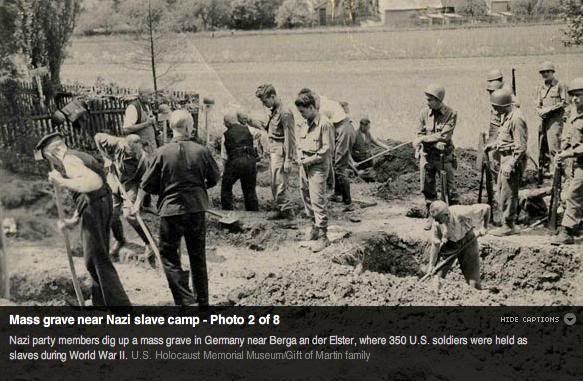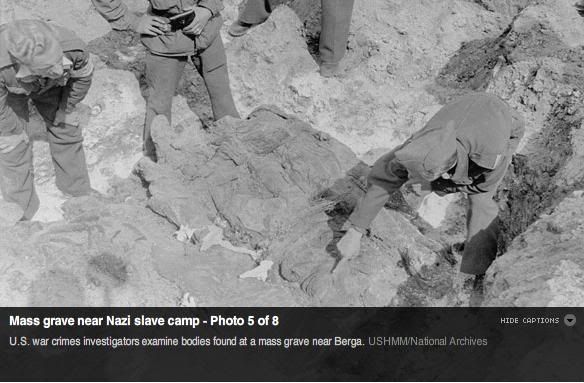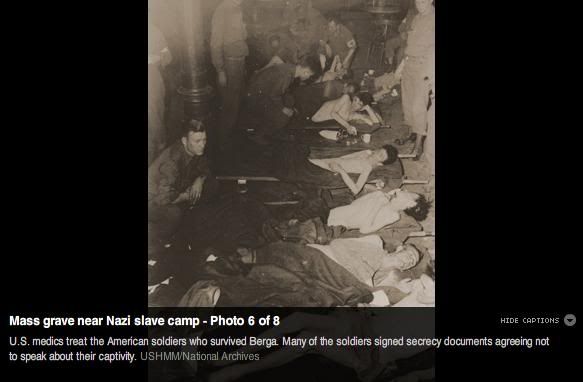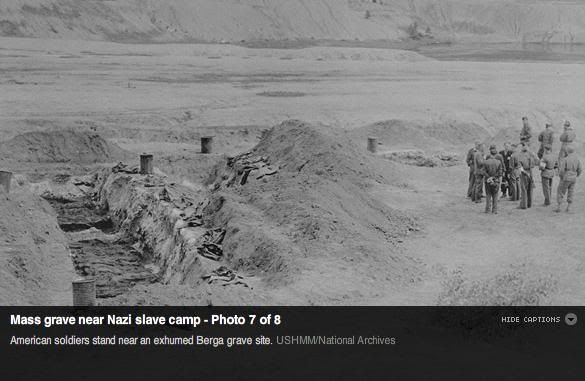For the benifit of future viewers, if the CNN article goes offline:
New photo: Nazis dig up mass grave of U.S. soldiersATLANTA, Georgia (CNN) -- The photograph is a jarring image that shows Nazi Party members, shovels in hand, digging up graves of American soldiers held as slaves by Nazi Germany during World War II.
While the men dig up the site, U.S. soldiers investigating war crimes stand over them. Two crosses with helmets placed atop them -- the sign of a fallen soldier -- are visible. Two Germans are knee deep in mud. Another, with a handlebar mustache, has the look of a defeated man. The bodies of 22 American soldiers were found in at least seven graves, according to the photographer.
On the back of the photo is written, "Nazi Party members digging up American bodies at Berga."
Berga an der Elster was a slave labor camp where 350 U.S. soldiers were beaten, starved, and forced to work in tunnels for the German government. The soldiers were singled out for "looking like Jews" or "sounding like Jews," or dubbed as undesirables, according to survivors. More than 100 soldiers perished at the camp or on a forced death march.
It was on this day six decades ago, April 23, 1945, when most of the slave labor camp soldiers were liberated by advancing U.S. troops. The emaciated soldiers, many weighing just 80 pounds, had been forced by Nazi commanders to march more than 150 miles before their rescue. Watch survivor break down in tears over liberation »
The new photograph was likely taken in May or June 1945 when U.S. war crimes investigators combed Berga. It was donated earlier this month to the U.S. Holocaust Memorial Museum by Jim Martin and his family, whose father, Elmore "Bud" Martin, is believed to have snapped the picture as part of the war crimes investigation team.
The photo and dozens of others sat for years in Jim Martin's closet. Some of the photos, including graphic images of American corpses, were placed on record at the National Archives years ago. See shocking photos of the slave camp »
But the image of Nazi Party members digging up graves doesn't appear to be part of that collection. Martin said he was proud to hand over the photos.
"People have to see these. This is something that's history and it belongs with something that's historical to tell that story. It doesn't belong in my closet."
"To be honest, I'm kind of sorry I haven't done it sooner. We didn't realize what it was."
Elmore Martin, who won a Silver Star for his valor in capturing images during the war, was 28 when he shot the photographs. Before the war, he worked as a photographer for the St. Paul Dispatch and Pioneer Press. Martin's son said his dad, who died several years ago, struggled to keep a job when he returned home. "I now see where it all started," he said.
What Elmore Martin and the war crimes soldiers seen in the photo couldn't have known that day was how the case would evolve.
The two Berga commanders -- Erwin Metz and his superior, Hauptmann Ludwig Merz -- were tried for war crimes and initially sentenced to die by hanging. But the U.S. government commuted their death sentences in 1948, and both men were eventually released in the 1950s. One other Berga commander, Lt. Willy Hack, was executed, but not by the United States. He died by hanging, justice carried out by the Soviets.
Jim Martin said his father would have been upset at the freeing of the Berga commanders after the atrocities he documented. "He knew it happened and to see that these people were released would be pretty devastating."
Efraim Zuroff, who has spent nearly 30 years hunting Nazis responsible for the Holocaust, said the U.S. government commuted the sentences and freed hundreds of war criminals like those at Berga after the war, as the Cold War began to intensify.
"They were more concerned about keeping out Communists than admitting victims of the Nazis," he said. "The realities out there were very conducive of letting these people off the hook."
How should Americans feel six decades later that the government freed the Nazi commanders responsible for atrocities against U.S. soldiers?
"We're supposed to feel very pissed off about that, to be perfectly honest, and that feeling is very justified," Zuroff said.
The German government has since made reparations to the soldiers held at Berga. Zuroff said now it's time for the U.S. government to do "the right thing."
"To apologize," he said.
The Army said it is trying to figure out the best way to honor the Berga soldiers. There are about 20 known survivors still living.
"The U.S. Army honors the service and sacrifice of all veterans who have fought our nation's wars. The Army is working to identify the most dignified and personal way to honor the soldiers held at the Nazi slave camp, known as Berga," Army spokesman Lt. Col. Willie Harris said in a written statement.
The Army refused to answer further questions about the Berga case. Listen in as an elderly man learns about his brother's death at the camp »
Survivors have long wanted to know why the sentences of the commanders were commuted. In a letter dated June 11, 1948, to an attorney whose nephew died at Berga, the U.S. War Department said the sentences of Metz and Merz were commuted because they were "underlings."
The letter goes on to say that Metz "though guilty of a generally cruel course of conduct toward prisoners was not directly responsible for the death of any prisoners, except one who was killed during the course of an attempt to escape." That soldier was Morton Goldstein.
Survivors say Goldstein tried to escape but was captured. They say Metz stood him against a wall, walked up to him and shot him, execution-style, through the head. As his body lay on the ground, guards riddled him with bullets, according to survivors.
The soldiers who survived were not called to testify at the war crimes trial against Metz and Merz, instead prosecutors relied on about a dozen soldiers' statements gathered through the course of the investigation. At the trial, Metz blamed any deaths at the camp on U.S. medics.
"They bore the sole responsibility for the medical care," Metz told the court, according to the book "Given Up for Dead," by Flint Whitlock, citing trial transcripts. "I ask you: Who must bear the responsibility? The answer is obvious: The U.S. medics."
Those comments don't sit well with Berga survivors. "He was terrible, absolutely terrible. He lied," said Tony Acevedo, a U.S. medic who catalogued the deaths in a diary at the camp. "Everybody hated his guts."
"Even the German guards were scared of him." Flip through Acevedo's diary from the slave camp »
Berga survivors say they await any recognition from the Army that may come, especially after all these years.
Morton Brooks, 83, said he constantly thinks about the day he was liberated. He was rail thin and had walked by political prisoners shot in the head during the forced death march. In the final hours before his rescue, his attitude was, "Let them kill us," he said.
"I think all the time that I'm a survivor of this and I'm still around," said Brooks. "To me, it just amazes me. I don't know how I got through."
Jim Martin said he's still trying to process his father's role as a forgotten American war hero, armed not with a gun, but a camera.
"The worst part is I'm just finding it out," he said.
Source: CNNPhotographs:






